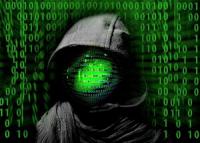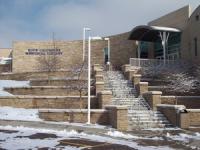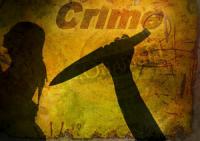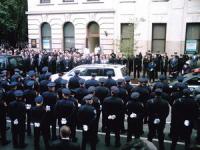-
How deeply has Germany’s murderous far right penetrated the security forces?
On June 2, Walter Lübcke was found dead in his garden with a bullet wound in the head. In his home town of Kassel, in the heart of Germany, the affable 65-year-old politician was a well-known member of Chancellor Angela Merkel’s center right party who had welcomed immigrants when she opened the country’s doors to refugees in 2015—and who had weathered a storm of hatred on social media as a result. Josephine Huetlin writes in the Daily Beast that at first, police insisted there was no political connection to the murder, and several investigators dismissed the possibility the killer came from the far right. But this week they arrested a suspect with neo-Nazi associations and a history of racist crimes. Now, the federal prosecutor’s office has taken over the case, which means it will be treated as an act of extremism and, in effect, of terrorism.
-
-
Germany investigates “right-wing extremist” murder of a pro-immigration politician
A German pro-immigration politician has been murdered in what appears to be an execution-style assassination. German Interior Minister Horst Seehofer has described the attack as “right-wing extremist” in nature, saying it was “directed against us all.”
-
-
Terrorist sympathizer who placed bombs in South Carolina roadways sentenced
A man and his daughter were driving down a rural highway in Anderson County, South Carolina, on 30 January 2018, when they noticed something odd—a glowing wicker basket in the middle of the road. On 4 and 15 February, the bomber placed other bomb-like devices in the area. Two more devices were found in the subsequent days. The FBI’s investigative and scientific teams cracked the case, and in February 2019 the culprit was sentenced to thirty years in prison.
-
-
Virginia Beach shooting reflects trend toward more powerful handguns
Like most mass shooters, the Virginia Beach gunman used a handgun. And like a growing number of American gun-buyers, he had a preference for some of the most powerful weapons available on the market. The use of semiautomatic handguns since 1990 has outpaced an already growing gun market.
-
-
Responding to the rise in domestic terrorism: Don’t forget prevention
The April attack on a synagogue in Poway, California, was the latest demonstration of the rise in extremist violence in the United States committed not by “jihadists” inspired by ISIS or other international terrorists, but by white supremacists, neo-Nazis or other right-wing groups. Eric Rosand writes in Lawfare that with the Tree of Life Synagogue attacks still fresh in many Americans’ minds, post-Poway discussions further highlighted how the resources and tools available to prevent right-wing extremist violence or domestic terrorism in the United States are dwarfed by those available to deal with the jihadist-inspired violence that data shows to be a much lesser threat. Rectifying this imbalance requires urgent attention.
-
-
Ghost guns are everywhere in California

Feds say nearly a third of firearms recovered in California are homemade, unserialized, and untraceable. Experts say the accessibility of ghost guns is aided by a cottage industry of retailers selling nearly completed firearms that require no screening to purchase.
-
-
UNC shooting has these things in common with other campus shootings
The 30 April shooting at the University of North Carolina at Charlotte follows a familiar pattern of mass shootings at college campuses in the United States. If authorities better understood these patterns, they may be able to prevent future shootings.
-
-
Transnational organized crime and national security
Traditional organized crime, ranging from the Italian-American mafia to street gangs, has long been a target of American law enforcement efforts. Eric Halliday writes in Lawfare that unlike purely domestic organized crime, transnational organized crime, defined by the Justice Department as groups that pursue criminal activities across geographic boundaries, has profound national security implications. The FBI warns that transnational organized crime poses a diverse array of national security threats related to border security, government corruption both in the United States and abroad, energy and “strategic material” markets around the world, and “logistical and other support to terrorists and foreign intelligence services.”
-
-
The darker side of the dark web: Weapons trade

Debates over gun regulations make headlines across the world, but there’s an underground operation for weapons that has drawn very little attention – until now. Researchers crept into the dark web to investigate how firearms are anonymously bought and sold around the world.
-
-
“Hardened” schools are not safe from gun violence

Hardening of schools seems to be a questionable endeavor, given the dearth of evidence regarding effectiveness, says an expert. A comprehensive review of the literature from 2000 to 2018 regarding school firearm violence prevention, found no programs or practices with evidence that they reduced such gun violence.
-
-
How Columbine became a blueprint for school shooters

When twelve students and one teacher were killed in Littleton, Colorado twenty years ago, it not only became what at the time was the worst high school shooting in U.S. history. It also marked when American society was first handed a script for a new form of violence in schools. Since the 1999 tragedy at Columbine High School, we identified six mass shootings and forty active shooter incidents at elementary, middle or high schools in the United States. In twenty – or nearly half – of those forty-six school shootings, the perpetrator purposely used Columbine as a model.
-
-
Knife-crime assault data to help forecast fatal stabbings

Knife crime data from a 12-month period could be used to help forecast the London neighborhoods most likely to suffer a fatal stabbing the following year, according to latest research.
-
-
Studying Perry Mason to combat “innocence fatigue”
Forensic science historian Professor Ian Burney is studying the influence of Erle Stanley Gardner, creator of renowned TV attorney Perry Mason, in a bid to reveal the roots of the fascination with stories about wrongful criminal conviction. Burney hopes the study will help better understand some of the challenges facing today’s worldwide “innocence projects.”
-
-
It is safer to be a cop today than 50 years ago

There is no doubt that policing is a dangerous profession. But is it safer to be a cop today than it was fifty years ago? Yes, according to a study that analyzed police officer deaths (felonious and non-felonious) in the United States from 1970 to 2016.
-
-
Do armed guards prevent school shootings?
The presence of guns in schools is a fact of life for millions of American children. Forty-three percent of public schools had an armed law enforcement officer during the 2015-2016 school year. Does increasing armed school security could reduce deaths from active shootings or deter the attacks in the first place? Experts say the data is not encouraging. Guns have stopped some mass shootings — but not usually in schools.
-
More headlines
The long view
How Male Grievance Fuels Radicalization and Extremist Violence
Social extremism is evolving in reach and form. While traditional racial supremacy ideologies remain, contemporary movements are now often fueled by something more personal and emotionally resonant: male grievance.
